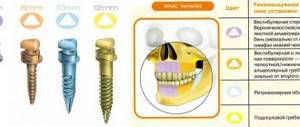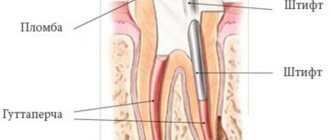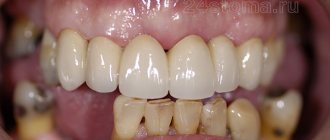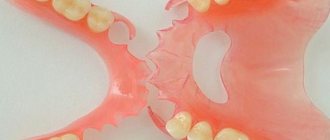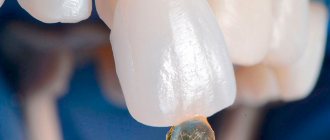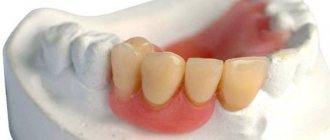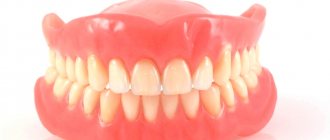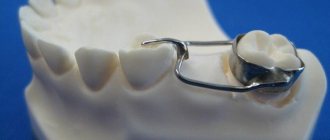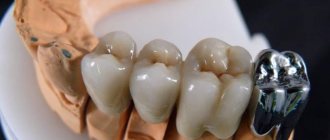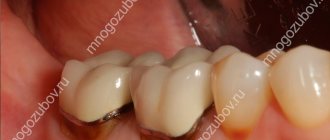Types of crowns for implants
What kind of crowns are placed on implants? Like regular dentures, implant-supported dental crowns come in a variety of types depending on the material. Today, the most popular materials used in the manufacture of crowns on implants are ceramics and metal-ceramics. Their main difference, as the name suggests, is the presence or absence of a metal frame in the design. Recently, it has become popular, for example, to install zirconium crowns on implants - all-zirconium or ceramic restoration structures made on a zirconium frame.
- Ceramic
Dentures made of ceramics are usually recommended to be installed in the area of the front teeth. Such structures are highly biocompatible, which means they do not have any negative effects on the soft tissues of the oral cavity. Plus, they look exactly like natural teeth. Ceramic crowns are more transparent, so in this case an abutment will be made of ceramic or zirconium. - Zirconium
Implant Crowns made from this modern material are most in demand by specialists today. The secret of their popularity is simple: they combine good aesthetic qualities and high strength. - Metal-ceramic
Metal-ceramic is perhaps the most common material used for the manufacture of dentures. Metal-ceramic crowns on implants for chewing teeth are inexpensive and reliable. They usually require a metal abutment.
Implantation and smoking
It is mandatory to quit smoking in the first 3-4 days after surgery to install implants (or before removing sutures, if they were applied). After the osseointegration process is completed, smoking is allowed, but you need to remember that the tars and carcinogens contained in cigarettes lead to increased accumulation of plaque, burns of the mucous membrane, and disruption of metabolic processes between the cells of all periodontal tissues. As a result, the risk of developing inflammatory processes and implant rejection increases. There is also a change in shade and rapid wear of the denture.
Therefore, we recommend giving up this bad habit completely. If this does not work, then you need to at least minimize the number of cigarettes consumed per day or switch to electronic analogues with a reduced content of harmful substances.
After smoking, be sure to perform oral hygiene - brush your teeth with toothpaste and a brush, rinse your mouth with mouthwash. This is a mandatory procedure that will minimize harmful effects.
If you smoke, then a complex of oral hygiene with a dental hygienist, together with a preventive examination of the condition of periodontal tissues, implants and dentures after complete implantation, must be completed more often than usual - at least 2 times. Talk to your hygienist about how best to enhance your hygiene.
What is the best crown to put on an implant?
The answer to this question depends on the area being implanted and your budget. If we are talking about chewing teeth and the patient does not want to overpay, then the doctor will most likely recommend metal ceramics. Zirconium crowns for chewing teeth will undoubtedly be the best option. However, it is also more expensive. If prosthetics takes place in the so-called smile zone, then it is better to place a crown on a ceramic implant. She will look not only beautiful, but also absolutely natural.
Pregnancy with dental implants
If you had dental implantation at a young age, then you can safely prepare for pregnancy - the presence of an implant is not a contraindication (provided that the structure has already fully fused with the bone tissue). The only thing you need to pay attention to is the condition of periodontal tissues during pregnancy, since hormonal changes occur during this period and gingivitis and periodontitis often occur, i.e. inflammation of the gum tissue.
During the entire period of pregnancy, it is necessary to see your dentist and pay increased attention to hygiene (you also need to see a therapist or hygienist more often - up to 3-4 times a year). It is also advisable to take vitamin complexes (calcium, vitamin D), unless, of course, there are contraindications. But only under the strict supervision of attending physicians (dentist and gynecologist).
Installing a crown on an implant
Installing a crown on an implant involves putting a specially machined crown on an abutment that connects it to the implant - an artificial root, while crowns for traditional prosthetics are made from casts of ground natural teeth and installed on previously prepared teeth.
How long does it take to place crowns on implants? It all depends on the clinical picture. If immediately after installation the implant is stable and there are no indications for delayed prosthetics, then the implantologist places a crown on the implant immediately. In the area of the chewing teeth, which are not visible when smiling, most likely, a crown will be placed several months after the final implantation.
Installation steps
- After installation, an abutment is placed on the dental implant. Essentially, it replaces the tooth stump that is left after preparing the tooth before installing a conventional crown.
- When the abutment is installed, the doctor takes an impression to subsequently make a permanent crown for the implant.
- The final stage of installing a dental crown on an implant is fixing the prosthesis to the abutment.
Implant mobility caused by erroneous actions of the doctor
If the implant begins to wobble during the healing period, for example, a month after installation, then the problem most often lies in the incorrect actions of the doctor while preparing the patient for implantation and directly during the installation operation. Since implantation is a complex undertaking, the doctor may make mistakes at different stages, both at the beginning and directly during the surgical intervention.
During preparation
Receiving false information about the condition of the bone where implants will be implanted. This is possible with insufficient and uninformative diagnosis, when other methods are used instead of computed tomography - orthopantomogram (OPTG) or radiography.
Incomplete preliminary examination (or complete refusal of it) of the patient to determine if he has relative and absolute contraindications that make implantation difficult or impossible. It is also possible that the doctor will not take into account the special hormonal status of women (menopause, postpartum or menstrual period) and will allow surgery during this period without taking into account the condition.
During the preparation of the treatment plan
Incorrect assessment of the place for the implant in the bone, the location of the artificial structure is too close to the roots of living teeth, with insufficient bone tissue.
Directly during surgery
There is a wide scope for incorrect actions: violation of the sterility of instruments and equipment, bacteria entering the prepared hole along with saliva, or when the edge of the implant touches any surface. The use of improperly sized implants, the use of structures for a different surgical protocol, overheating of the bone tissue when forming a bed for the implant, installation of the rod at the wrong angle, excessive deepening of the rod, etc.
For prosthetics
During the manufacture of the prosthesis, violations may occur, resulting in incorrect distribution of the chewing load, inconsistency of the prosthesis with the implants, penetration of the cement composition into the socket, prosthetics of only one row without taking into account the load on the second, and others.
In order not to encounter unpleasant consequences of implantation, a specialist must be chosen carefully, based on many indicators of his work. How not to make a mistake with your choice, read the material “How to choose a doctor and clinic?”
Fixation of the crown on the implant: screw and cement
There are two ways in which you can place a crown on an implant - screw and cement. Screw-retained implant crowns involve drilling a hole in a prefabricated crown, which is later sealed. A screw is inserted through it, passes through the crown and is screwed into the abutment. All this happens outside the patient's mouth. When the crown and abutment are securely connected, the latter is secured in a special hole in the implant. Cement fixation of a crown on an implant is similar to the installation of a conventional crown: it is glued to the abutment using special cement - a composite material, while the abutment is already securely fixed in the implant, and the installation procedure takes place directly in the patient’s oral cavity.
All of the above applies to permanent crowns - those that are installed some time after implantation, when the first period of engraftment passes. But in most cases, implantation involves the possibility of instantly loading the implant with a temporary crown.
Rules of nutrition after implantation
Your diet has long become complete - the period has passed when quite strict restrictions were imposed in terms of the hardness of foods and the temperature of dishes. However, even now, after the implants have completely implanted, you will still have to give up a number of products.
- Chew food thoroughly, using both sides - all installed implants should receive an even load. If there is discomfort and you notice that you are chewing food on only one side, consult a doctor immediately.
- introduce a maximum of healthy foods into your diet - food should be rich in various groups of vitamins,
- Do not bite off hard vegetables and fruits - they must first be cut into small pieces. It is better to grate carrots before eating, because... it's too hard to chew
- It is better to exclude shish kebab and hard fried meat - give priority to boiled, stewed meat, and cutlets. The veins contained in meat products get clogged under the prosthesis - it is very difficult to remove them,
- nuts are prohibited - the problem is not even that they are too hard. Like meat, they get stuck under the prosthesis and are very difficult to remove from under it,
- but at the same time, the food should not be soft - it is important to give a reasonable load to both prostheses and implants,
- it is important to drink as much water as possible, chilled herbal or fruit teas,
- exclude (or at least minimize) wine, beets, black tea and coffee, which lead to staining and permanent discoloration of the denture,
- also exclude foods and drinks that contain acids, bites - they can lead to irritation and inflammation of the mucous membranes,
- It is allowed to drink hot drinks and eat cold ice cream, but you cannot combine them to avoid sudden temperature changes.
Use your teeth only for their intended purpose, namely for chewing food! They cannot be used to open bottles, remove corks, or crack nuts. Although they are artificial, they will easily break under increased load.
Why are temporary crowns needed for implants?
Temporary crowns on implants are installed primarily for aesthetic reasons, so that the patient does not walk around with a “hole” in the mouth for the entire healing period. This is especially true for prosthetics in the smile area. In addition, the temporary crown, although not always fully functional, is still involved in speech and chewing. It is distinguished from a permanent crown by the material of production - light plastic, and therefore also by cost and weight. These parameters are important, since spending a lot of money on a temporary crown, which is not needed for a long period of time, is inappropriate, and loading a newly installed implant with a crown of full weight is dangerous. At the same time, externally, temporary crowns are practically indistinguishable from permanent ones, and therefore from natural teeth, their color is matched to the shade of the enamel of the surrounding teeth, all this allows you to hide the prosthetic process from prying eyes.
Implantation and alcohol
Remember that the effects of alcohol are very harmful to the entire body. Therefore, we insist that the consumption of drinks that contain even a negligible amount of alcohol must be limited and kept to a minimum.
- While intoxicated, you may perform inappropriate actions. For example, getting into a fight, which will lead not only to damage to the prostheses, but also to displacement of the installed implants,
- hygiene is difficult or impossible - when a person is heavily intoxicated, he cannot control his actions. If you carry out hygiene in this state, you can damage the gums around the implants, which can lead to the development of inflammation and subsequent rejection of the structures,
- appetite increases - you can damage the implants by eating prohibited, too hard food,
- your immunity will stop working at full strength,
- alcohol has a negative effect on the mucous membranes, especially if they are inflamed (you may not know about the presence of a problem if you have not had a preventive examination with a doctor for a long time),
- you forget that you need to visit a doctor: such situations arise in cases where the patient drinks alcoholic beverages for a long period of time,
- you may lose your warranty.
Drinking alcohol should not become an obstacle to living a full life and maintaining the results of expensive treatment!
Which is better, a crown or an implant?
When asking a similar question, patients most often mean the installation of dentures based on their own teeth and implantation. What is the difference between a regular crown and an implant? In order to install a conventional bridge, it is necessary to grind down the healthy teeth adjacent to the defect, which will begin to decay over time and the bridge will have to be lengthened. This cannot happen with an implant. Its installation does not affect the “neighbors” in any way, and its service life is not limited. Only the crown will have to be changed. The service life of crowns on implants is about 10 - 12 years, and in many cases reaches 15 years, while with traditional prosthetics, the crown must be changed every 5 - 7 years, grinding the teeth in a new way.
General rules: what is allowed and what is prohibited
- air travel – fly and travel without restrictions, explore the world and taste new dishes (but with minor restrictions - more about them in the “food” section),
- physical activity – play sports and maintain your health. But exclude lifting excessive weights (in particular, when doing powerlifting) and sports activities that are associated with injuries to the maxillofacial area,
- visit swimming pools without restrictions, but use baths and saunas with caution (severe overheating is not recommended). The temperature of the steam room should be average, the length of stay should be minimal (no longer than 10 minutes),
- keep your body healthy. If you have been diagnosed with diabetes mellitus or diseases of the cardiovascular system, remember that if the condition worsens, metabolic disorders in periodontal tissues may occur, which carries a risk of rejection of structures. Be sure to take medications prescribed by your specialist and monitor your blood pressure and blood sugar.
Visit your doctor at least once a year for a preventive examination, and in case of unsatisfactory self-hygiene and doctor’s indications, more often - 2-4 times a year for professional oral hygiene. This will allow, firstly, to maintain healthy gums and achieve high-quality cleansing of pathogenic microflora, and secondly, to eliminate possible complications in the early stages and promptly eliminate them.
How is it different from cement mounting?
Fixation with cement is performed in stages:
- The abutment is prepared, impressions are taken and the prosthesis is made.
- The cement is placed into the crown cavity and placed on the abutment.
- A special lamp is used to harden the cement.
Differences between the cement method and the screw method:
- There is no hole on the occlusal surface, which improves aesthetics.
- The installation process is reminiscent of classic bridges.
- No passive landing required.
- Replacing an orthopedic structure is difficult.
- The process requires more attention from a specialist.
Choosing the best crown
Let's decide which crowns are best placed on implants. A good solution in terms of price and quality are metal-ceramic ones, but in the frontal zone they can lead to “blueness” of the gums. Therefore, the best option is zirconium dioxide. Their price may seem high to some, but it is fully compensated by their service life. After all, while you are wearing a zirconium dioxide prosthesis, the metal ceramics will have to be changed at least once - this is extra money and time.
“I definitely won’t get metal-ceramics for myself anymore, because it makes my gums look very ugly. I don't want to smile. Therefore, when the old bridges became loose and I had to put in implants, I immediately told the dentist that we’d better use zirconium. Honestly, I’ve been wearing new teeth for 2.5 years now and you can’t tell them apart from real ones, and my gums are fine.”
Svetlana A., 42 years old, review from irecommend.ru
Does it hurt to remove a crown?
No, especially if the procedure is performed under anesthesia. Removing a crown from a tooth is painful if there is a living tooth underneath it that is undergoing an inflammatory process, but in the vast majority of cases, crowns are placed on pulpless teeth. In such a situation, the procedure may cause some discomfort, but you most likely will not experience severe pain. If your teeth hurt after removing crowns, there are two options. Either mechanical damage has been caused to the gum, or pulpitis, periodontitis or granuloma develops in the tooth. In this case, complex endodontic treatment is required.
How does the withdrawal take place?
The procedure for removing a dental crown can be done in different ways. The most common of them is using the Koch apparatus. This device is placed in the patient's mouth, and by applying pressure to the edge of the crown, the crown is “displaced” without pain or damage. This method is often used when the patient wants to keep the dental crown intact. If the integrity of the crown is not so important, you can remove the crown by simply sawing it. This method often frightens patients, since the preparation process is quite complicated. During filing, ultrasound is applied to the tooth, causing the material to crack, allowing the tooth to be freed. Sawing severely damages the structure, so installing the same crown will not be possible.
You can carefully remove the crown using the Coronaflex device. The orthopedic design completely retains its shape, so it can be reinstalled.
